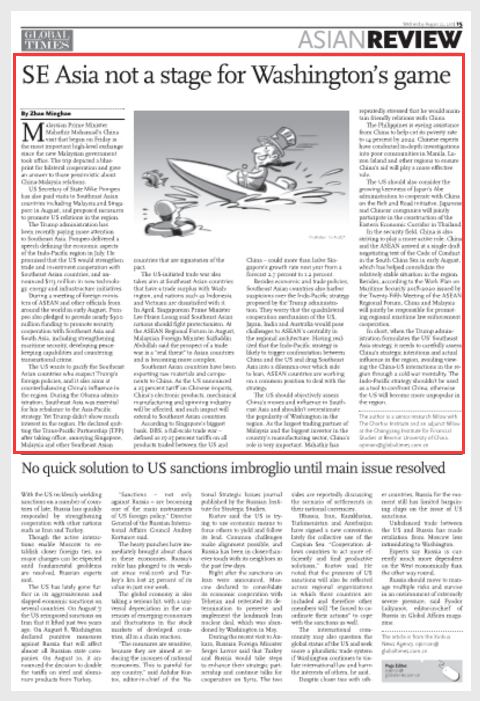Major Power Relations
Your Present Location: PROGRAMS> Major Power RelationsZhao Minghao: Southeast Asia not a stage for Washington’s game
By Zhao Minghao Source: Global Times Published: 2018-8-21
Malaysian Prime Minister Mahathir Mohamad's China visit that began on Friday is the most important high-level exchange since the new Malaysian government took office. The trip depicted a blueprint for bilateral cooperation and gave an answer to those pessimistic about China-Malaysia relations.

US Secretary of State Mike Pompeo has also paid visits to Southeast Asian countries including Malaysia and Singapore in August, and proposed measures to promote US relations in the region.
The Trump administration has been recently paying more attention to Southeast Asia. Pompeo delivered a speech defining the economic aspects of the Indo-Pacific region in July. He promised that the US would strengthen trade and investment cooperation with Southeast Asian countries, and announced $113 million in new technology, energy and infrastructure initiatives.
During a meeting of foreign ministers of ASEAN and other officials from around the world in early August, Pompeo also pledged to provide nearly $300 million funding to promote security cooperation with Southeast Asia and South Asia, including strengthening maritime security, developing peacekeeping capabilities and countering transnational crime.
The US wants to pacify the Southeast Asian countries who suspect Trump's foreign policies, and it also aims at counterbalancing China's influence in the region. During the Obama administration, Southeast Asia was essential for his rebalance to the Asia-Pacific strategy. Yet Trump didn't show much interest in the region. He declared quitting the Trans-Pacific Partnership (TPP) after taking office, annoying Singapore, Malaysia and other Southeast Asian countries that are signatories of the pact.
The US-initiated trade war also takes aim at Southeast Asian countries that have a trade surplus with Washington, and nations such as Indonesia and Vietnam are dissatisfied with it. In April, Singaporean Prime Minister Lee Hsien Loong said Southeast Asian nations should fight protectionism. At the ASEAN Regional Forum in August, Malaysian Foreign Minister Saifuddin Abdullah said the prospect of a trade war is a "real threat" to Asian countries and is becoming more complex.
Southeast Asian countries have been exporting raw materials and components to China. As the US announced a 25 percent tariff on Chinese imports, China's electronic products, mechanical manufacturing and spinning industry will be affected, and such impact will extend to Southeast Asian countries.
According to Singapore's biggest bank, DBS, a full-scale trade war - defined as 15-25 percent tariffs on all products traded between the US and China - could more than halve Singapore's growth rate next year from a forecast 2.7 percent to 1.2 percent.
Besides economic and trade policies, Southeast Asian countries also harbor suspicions over the Indo-Pacific strategy proposed by the Trump administration. They worry that the quadrilateral cooperation mechanism of the US, Japan, India and Australia would pose challenges to ASEAN's centrality in the regional architecture. Having realized that the Indo-Pacific strategy is likely to trigger confrontation between China and the US and drag Southeast Asia into a dilemma over which side to lean, ASEAN countries are working on a common position to deal with the strategy.
The US should objectively assess China's moves and influence in Southeast Asia and shouldn't overestimate the popularity of Washington in the region. As the largest trading partner of Malaysia and the biggest investor in the country's manufacturing sector, China's role is very important. Mahathir has repeatedly stressed that he would maintain friendly relations with China.
The Philippines is eyeing assistance from China to help cut its poverty rate to 14 percent by 2022. Chinese experts have conducted in-depth investigations into poor communities in Manila, Luzon Island and other regions to ensure China's aid will play a more effective role.
The US should also consider the growing keenness of Japan's Abe administration to cooperate with China on the Belt and Road initiative. Japanese and Chinese companies will jointly participate in the construction of the Eastern Economic Corridor in Thailand.
In the security field, China is also striving to play a more active role. China and the ASEAN arrived at a single draft negotiating text of the Code of Conduct in the South China Sea in early August, which has helped consolidate the relatively stable situation in the region. Besides, according to the Work Plan on Maritime Security 2018-2020 issued by the Twenty-Fifth Meeting of the ASEAN Regional Forum, China and Malaysia will jointly be responsible for promoting regional maritime law enforcement cooperation.
In short, when the Trump administration formulates the US' Southeast Asia strategy, it needs to carefully assess China's strategic intentions and actual influence in the region, avoiding viewing the China-US interactions in the region through a cold war mentality. The Indo-Pacific strategy shouldn't be used as a tool to confront China, otherwise the US will become more unpopular in the region.
The author is a visiting fellow at the Chongyang Institute for Financial Studies at Renmin University of China.























































































 京公网安备 11010802037854号
京公网安备 11010802037854号





